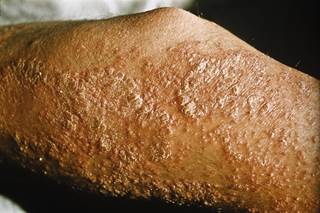February 19, 2019

Acute skin manifestations correlated with axial disease and were more common among young participants and those with higher body mass index. Photo Credit: BSIP/Science Source
Among individuals with psoriatic arthritis (PsA) and moderate to acute skin manifestations, axial disease is more common and has an earlier onset, according to a study recently published in the Journal of Dermatology. Additionally, anti-tumor necrosis factor-α inhibitors (anti-TNF- α) have demonstrated reduced efficacy among individuals older than 50 years.
This cross-sectional, retrospective study included 2116 individuals with psoriasis and was conducted in western Japan. Medical records were gathered and psoriasis and PsA were analyzed by physicians according to the Classification Criteria for Psoriatic Arthritis. Categorical data were examined using Fisher’s exact test and continuous variables by Student’s t-test, with confounding factors removed through logistic regression.
In this cohort, 13.5% (n=285) had a diagnosis of PsA. This was preceded by skin manifestations in 69.8% of cases, with a median time of 7 years between skin manifestations and arthritis onset. The 2 conditions occurred at the same time among 17.2%, and just 2.5% showed PsA before skin manifestations. The majority of cases were peripheral arthritis (73.7%), followed by dactylitis (35.4%), enthesitis (23.5%), and axial disease (21.8%). Acute skin manifestations correlated with axial disease (P =.03) and were more common among young participants (P =.01) and those with higher body mass index (P =.02).
TNF-α inhibitors were administered to 157 participants and were continued by 105, with 47 discontinuing them. This discontinuation correlated significantly with being older at the time of joint manifestations (50 vs 44 years; P =.01) and being older in general (55 vs 51 years; P =.04). Those older than 50 years were 3.65 times more likely to discontinue TNF-α inhibitors (P <.01).
Limitations to this study included that the cohort exclusively included Japanese participants, a cross-sectional study design, and a lack of longitudinal observation.
The study researchers concluded that “13.5% of individuals with psoriasis in our large survey had PsA. Our finding that axial disease is present more frequently in patients with moderate [or] severe manifestations is new, as is the finding that TNF inhibitors are less effective in older patients with PsA, suggesting the presence of other overlapping conditions.”
Reference
Tsuruta N, Narisawa Y, Imafuku S, et al. Cross-sectional multicenter observational study of psoriatic arthritis in Japanese patients: relationship between skin and joint symptoms and results of treatment with tumor necrosis factor-α inhibitors [published online January 10, 2019]. J Dermatol. doi: 10.1111/1346-8138.14745